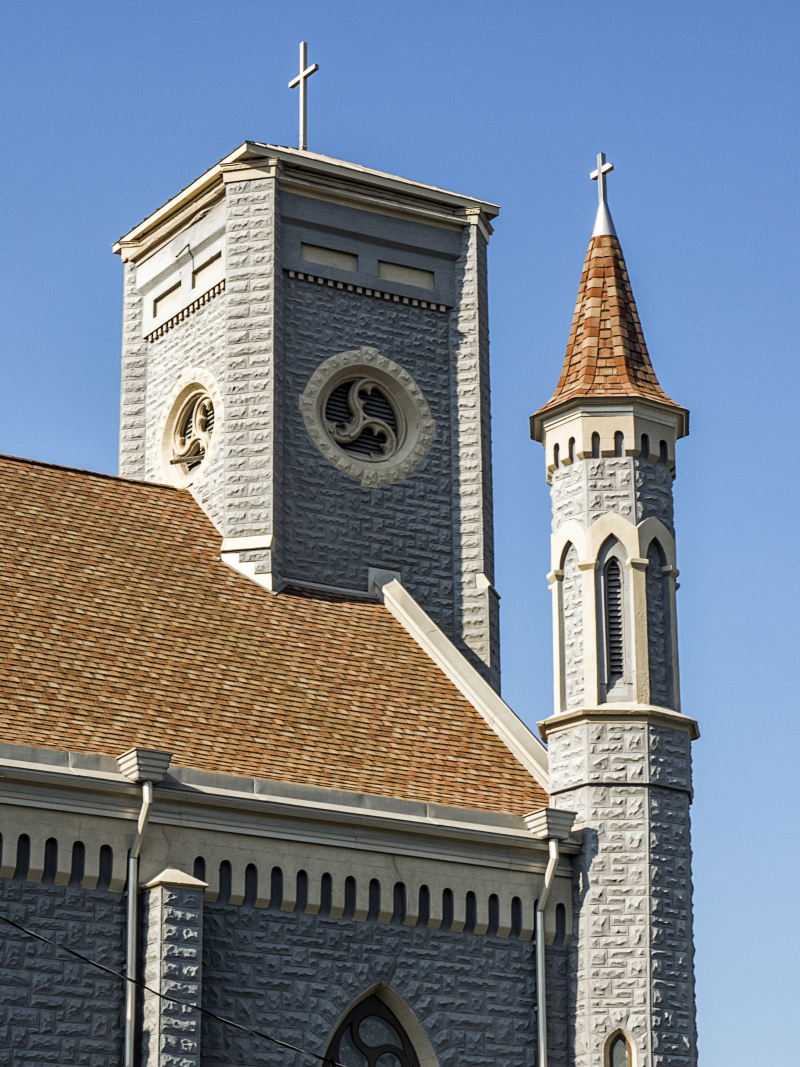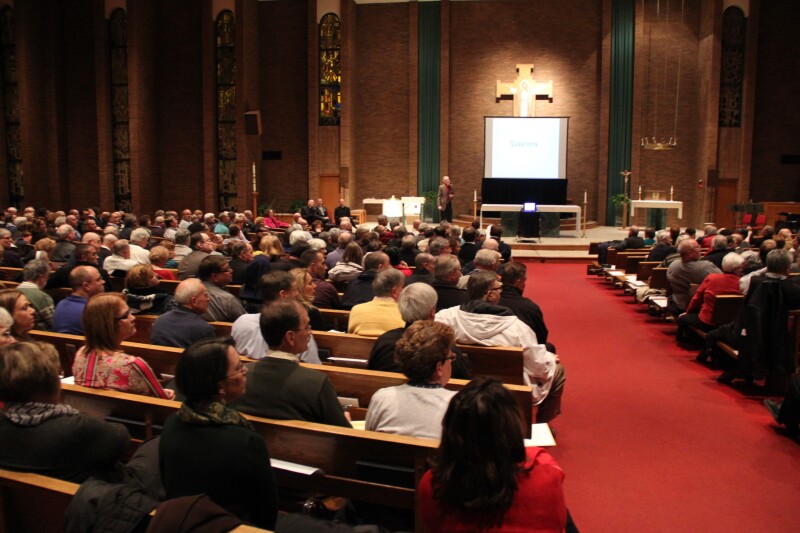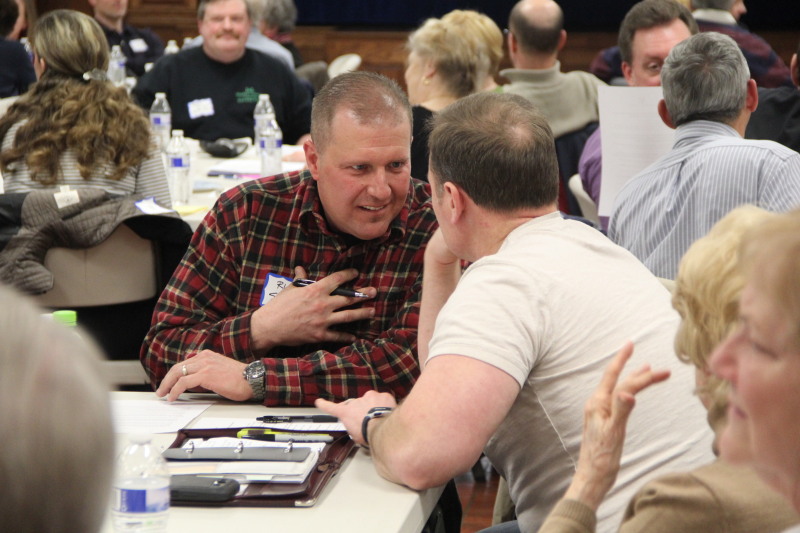
PARISHES CONSIDER MERGERS FOR FUTURE
Dana Massing
02/01/2022

Epiphany of the Lord Parish in Meadville after the area's three parishes
merged as the result of regional planning. Photo/Melinda Isachsen
Declining attendance in the Catholic Diocese of Erie is no secret.
Based on the results of an annual October count, which Bishop Lawrence Persico made public in 2021, attendance was down by 32.2% when comparing 2021 with 2019. No count was taken in October 2020, and the pandemic didn’t help attendance. But when looking at 2021 versus 2016, the total was down 43.2%, according to October count results on the diocese’s website.
With fewer worshippers and other challenges including fewer priests, parishes across the 13-county Erie-based diocese are talking about the future. For some, the word “merger” is at least part of the conversation. “There’s no cookie-cutter solution,” Monsignor Edward Lohse, vicar general for the diocese, said.
He said that since a pastoral planning process was completed for the diocese in 2017, its leaders have been encouraging local grassroots processes for thinking about the future. That means parish priests, councils and people all over the diocese looking at what their churches can and can’t continue to do. “All kinds of them” are at least talking about merging in some way, Lohse said.
“It’s actually going on all over the diocese,” he said.
However, he doesn’t expect any mergers to take place in the near future.
“Most of them are still in the discernment process,” he said.
Loshe said merger is a topic of discussion in the DuBois, Bradford and Oil City deaneries. He said the discussion has been less formal among all the east Erie parishes but it’s still occurring.
“They are all talking together,” he said of the parishes in the Erie East Deanery. “It’s in its early stages.”
In west Erie, three parishes that are already partnered – Sacred Heart, St. Andrew and St. Paul – had recently been considering consolidating. However, their pastor, the Rev. Mark O’Hern, announced at a listening session in December that they were going to “hold off on proceeding further.”
In the meeting, which can be viewed on YouTube, he said, “So what that basically means is we’re going to be holding in stasis.”
O’Hern told the Erie Times-News that Mass attendance had dropped over the past decade at the parishes and the declining number of priests available to serve was a concern. He also said that the three parishes were all still able to pay their bills.
“The fiÂnances was not our primary cause for talking about consolidation,” he said.
He said parishioners’ reactions to the idea of consolidating were mixed and did include opposition.
“It’s a very tough decision for people,” O’Hern said. “It’s a decision people don’t want to make.”
He said it’s hard for some to be objective when it’s their parish that could be merging.
O’Hern said a decision was made to maintain the status quo at his three parishes while keeping an eye out for any

of the three vicariates of the diocese when pastoral planning began in
2015. Pictured above: Our Lady of Peace, Erie, in the Northern Vicariate.
Photo/Anne-Marie Welsh
other changes that might be coming for Catholic churches in Erie.
Differences between partnering and merging
The partnering of Sacred Heart, 816 W. 26th St.; St. Andrew, 1116 W. Seventh St.; and St. Paul, 1617 Walnut St., was part of the diocese’s pastoral planning process announced in September 2016.
In the Erie diocese, Lohse said, partnering means two or more distinct parishes sharing a pastor. They are also asked to share staff and an offiÂce.
Merging, he said, is when two or more parishes become one. In the Erie Diocese, that most commonly occurs when one parish absorbs another. Typically, the church building from the absorbed parish becomes a “secondary church” of the absorbing parish and doesn’t always continue to have regular Sunday Masses. A merger doesn’t mean the automatic closing of buildings, although some secondary churches have closed.
“As a general rule, we do not close churches when we combine parishes,” Lohse said.
Bishop Persico chose not to close church buildings himself as part of the restructuring. However, he indicated that a parish could request that a church be closed, technically “relegated to profane but not sordid use,” meaning the bishop removes the blessing or consecration of the church building and it ceases to be reserved for divine worship and can be used for non-religious purposes.
Before the restructuring, Erie’s St. Mary of the Immaculate Conception Church merged with St. Stanislaus Church in 2015 and St. Mary closed. In 2017, the former St. Mary building at 315 E. Ninth St. was sold to New Life and Spirit Revival Center, a nondenominational Erie ministry.
In Oil City, Assumption of the Blessed Virgin Mary Church became a secondary church when it merged into St. Joseph Parish in 2017 as part of the diocesan restructuring. Assumption was later closed and the deteriorating building that was constructed in 1907 was demolished in November 2020.
When the fiÂnal parish restructuring plan was announced in 2016, the diocese had 116 parishes and 141 church buildings. There are now 94 parishes and 128 church buildings, diocesan offiÂcials said. Of the churches, 120 have at least one weekend Mass, meaning on a Saturday or Sunday, a spokeswoman said.

of the diocese during the initial phase of pastoral planning. Above:
parishioners from parishes in Elk County. Photo/AMWelsh
Merging into a new parish
Another merger option is for two or more parishes to become one new parish. That kind of merger is less common in the Erie diocese but was the most recent, when Meadville’s St. Agatha, St. Brigid and St. Mary of Grace, which had been partnered, merged in June to form The Epiphany of the Lord Parish.
According to a decree from Persico on merging the churches and establishing the new parish, among the reasons for the change were the decline in the Catholic population of Meadville and the decline in the number of priests. Also cited were “the need to reorganize the Catholic community of Meadville to build a more stable foundation for future ministry” and “the need to make more prudent use of scarce resources – fiÂnancial and other.”
“It’s been good,” said Epiphany’s pastor, the Rev. JeffÂrey Lucas. “It’s also been a transition for people.”
He said that forming a new parish eliminated the problem of one of the three being seen as the “last one standing.”
The new parish is housed at the former St. Agatha Church, 353 Pine St., Meadville, while St. Brigid, 383 Arch St., and St. Mary of Grace, 1085 Water St., became secondary churches.
Saturday and Sunday Masses are at the St. Agatha building. The St. Brigid and St. Mary sites each have one noon weekday Mass and are also used for other purposes.
Lois Curtin’s one granddaughter got married at St. Brigid in June and another will be married there in August.
“I know it’s diffiÂcult. It’s hard,” Curtin, who was a longtime St. Brigid member, said about a merger. “You have to really look at the whole picture.”
Lucas said merging isn’t easy for anybody, but people are realizing it might be the only way to make the best uses of facilities and resources.
For the Meadville parishes, he said, it was establishing one large community to be the “all-star team” of what good things had been taking place at the three parishes.
“The best way for us to keep a vibrant Catholic presence was to consolidate,” Lucas said.
Curtin, of Meadville, understood the need. She’d been through it before when the St. Brigid and St. Agatha schools merged as Seton Catholic School in the 1970s.
Curtin, 84, joined St. Brigid Catholic Church in 1963. Her four children were baptized and their weddings were held there. They attended St. Brigid School. But then the time came when the school got small, she said.
She said the school merger was painful but it worked out fiÂne, and the name change helped.
“I saw the hurts, but I saw a really good school come out of it,” she said.
So Curtin, a longtime parish council member, said she understood and was open to talking about merging St. Brigid, St. Agatha and St. Mary parishes. She said many people knew it was coming.
‘We have to be able to adjust’
Lohse said that blending faith communities is delicate work. Many have been around for generations and have their own history and gifts. Sometimes people need more time and space to think about merging. He said the pandemic slowed things down. That’s not a bad thing, he said, adding that it’s OK to give people more time to think, do the groundwork and own the decision.
“Our goal is that everybody move forward with us,” Lohse said. “We don’t want to lose anybody along the way.”
There is no set timetable for churches to talk or make decisions about mergers, he said. If parishes want help, the diocese has guides and facilitators.
Meadville’s Lucas said the diocese’s process and help for mergers was extremely useful and he advised other parishes to take advantage of it.
He and Lohse also said that prayer was very important in the process. Lohse encouraged parishioners to pray for guidance on how to reposition themselves to carry the Gospel to future generations. He also suggested discerning, discussing and being open to the guidance of the Holy Spirit.
While recognizing that there are natural bonds connecting people to church buildings, Lucas said those connections might need to be severed and parishes might be called to take a pioneering step and do something new to meet the needs of the future.
“Champions adjust and we have to be able to adjust,” he said.
Curtin admits that she misses St. Brigid, which once had three priests of its own, but said it’s been nice to get to know people from St. Agatha and St. Mary.
“I think it’s expanded our horizons,” she said.
If the three parishes hadn’t merged, she believes one or two might have closed. Instead, she said, something new has emerged.
“I think it’s the cycle of life,” Curtin said.
Lucas said he’s enthusiastic about what is ahead.
“Keep your eye on the future you’re going to build,” he said to other parishes thinking or talking about merging.
Curtin advised them to remember the bottom line.
She said she thinks Epiphany of the Lord will eventually have to close and sell one or both of its secondary churches.
“We love our churches, but we love our faith more,” Curtin said. “It’s way more important.”
Lohse said parishes are succeeding “fairly well” after mergers and while not without a certain sense of loss, they are moving forward.
“I do think they have found new vigor and new life,” he said.
Lohse also said that parishes have been opening and closing in the diocese for more than 150 years, although there’s historically been greater stability in Erie.
“It’s just part of being a living, growing community,” he said.
© Dana Massing – USA TODAY NETWORK
Reprinted with permission
-
